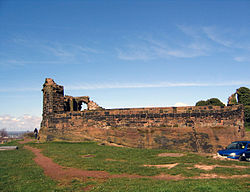Halton Castle
| Halton Castle | |
|---|---|

Part of Halton Castle ruins in 2006
|
|
| Location | Halton, Cheshire, England |
| Coordinates | 53°19′59″N 2°41′45″W / 53.3331°N 2.6957°WCoordinates: 53°19′59″N 2°41′45″W / 53.3331°N 2.6957°W |
| OS grid reference | SJ 537,821 |
| Built | 11th century |
| Built for | Nigel of Cotentin |
| Architectural style(s) | Castle |
| Governing body | Norton Priory Museum Trust |
|
Listed Building – Grade I
|
|
| Designated | 23 April 1970 |
| Reference no. | 1130460 |
| Designated | 26 November 1963 |
| Reference no. | 1015606 |
Not to be confused with Alton Castle.
Halton Castle is in the former village of Halton which is now part of the town of Runcorn, Cheshire, England. The castle is situated on the top of Halton Hill, a sandstone prominence overlooking the village. It is recorded in the National Heritage List for England as a designated Grade I listed building, and a scheduled ancient monument.
It was the seat of the Barons of Halton from the 11th century until the 14th century and it then passed to the Duchy of Lancaster. It was besieged twice in the Civil War after which its structure deteriorated. In the 18th century a new courthouse was built on the site of the previous gatehouse. The castle lies in ruins apart from the courthouse which has been converted into a public house.
Although there is no surviving evidence, it is likely that Halton Hill was a settlement in prehistoric times. Following the Norman conquest, the Barony of Halton was established by Hugh Lupus, Earl of Chester. The first baron to be appointed was Nigel of Cotentin and it is almost certain that he would have built a motte and bailey castle on the site, constructing it from wood, although the excavations in 1986–87 showed no evidence of a motte and bailey structure or of a timber tower or palisade. It is most probable that during the 12th century the wooden structure was replaced by a castle built from the local sandstone although no documentary evidence of this remains. Details of the building works are obscure but it has been suggested that John of Gaunt, the 14th baron, made alterations to the castle but this again has not been confirmed by documentary evidence. When the 15th baron, Henry Bolingbroke, ascended the throne as King Henry IV, the castle became the property of the Duchy of Lancaster.
...
Wikipedia

